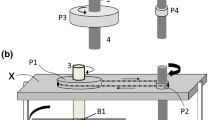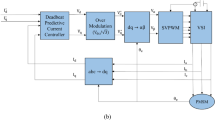Abstract
This paper deals with double saliency switched reluctance motor for automotive application by offering simultaneously a design solution to the drawbacks of torque ripples and emitted noise caused by the important radial efforts. The work concerns the optimization of the motor structure, the main objectives is the reduction of the first harmonics of torque and radial force applied on the stator teeth. This geometric optimization is performed on operating points where the instantaneous computation of supply current is taken into account to resolve simultaneously both problems. This operating point is defined as torque–speed point by considering the instantaneous characteristics of the machine when the steady state is established.











Similar content being viewed by others
References
Husain I (2002) Minimization of torque ripple in SRM drives. IEEE Trans Ind Electron 49(1):28–39
Cameron DE, Lang JH, Umans SD (1992) The origin and reduction of acoustic noise in doubly salient variable-reluctance motors. IEEE Trans Ind Appl 28(6):1250–1255
Pollock C, Wu CY (1995) Acoustic noise cancellation techniques for switched reluctance drives. In: Industry applications conference. Thirtieth IAS annual meeting, IAS’95, conference record of the 1995 IEEE, vol 1, pp 448–455
Yoshida A, Tanaka D, Miki I (2005) A study on the reduction of vibration and acoustic noise for switched reluctance motor. In: Proceedings of the eighth international conference on electrical machines and systems, 2005. ICEMS 2005, vol 1, pp 520–523
Kolli A, Krebs G, Mininger X, Marchand C (2012) Impact of command parameters on efficiency, torque ripple and vibrations for switched reluctance motor. In: XXth international conference on electrical machines (ICEM), vol 2012, pp 2975–2980
Hofmann A, Al-Dajani A, Bosing M, De Doncker RW (2013) Direct instantaneous force control: a method to eliminate mode-0-borne noise in switched reluctance machines. In: electric machines drives conference (IEMDC). IEEE international, vol 2013, pp 1009–1016
Fahimi B, Suresh G, Rahman KM, Ehsani M (1998) Mitigation of acoustic noise and vibration in switched reluctance motor drive using neural network based current profiling. In: Industry applications conference, 1998. Thirty-third IAS annual meeting. The 1998 IEEE, vol 1, pp 715–722
Suryadevara R, Fernandes BG (2013) Control techniques for torque ripple minimization in switched reluctance motor: an overview, pp 24–29
Lecointe JP (2003) Etude et réduction active du bruit d’origine magnétique des machines à réluctance variable à double saillance, Artois
Mininger X (2005) Réduction des vibrations des machines à réluctance variable à l’aide d’actionneurs piézoélectriques. Thesis, École normale supérieure de Cachan-ENS Cachan
Tang Y (1999) Switched reluctance motor with damping windings, US6008561 A, 28 Dec 1999
Besbes M, Picod C, Camus F, Gabsi M (1998) Influence of stator geometry upon vibratory behaviour and electromagnetic performances of switched reluctance motors. IEE Proc Electr Power Appl 145(5):462–468
Hong J-P, Ha K-H, Lee J (2002) Stator pole and yoke design for vibration reduction of switched reluctance motor. IEEE Trans Magn 38(2):929–932
Randall SP (2000) Noise reduction in reluctance machines, US6072260 A, 06 Jun 2000
Ayari S (2000) Etude des vibrations des machines à reluctance variable: influence des caractéristiques géométriques et de l’excentricité rotorique. Ecole Normale Superieure de Cachan, France
Anwar MN, Husain I (2000) Design perspectives of a low acoustic noise switched reluctance machine. In: Industry applications conference, 2000. Conference record of the 2000 IEEE, vol 1, pp 99–106
Rasmussen PO, Andreasen JH, LaBrush EC (2005) Interlaminated damping—a method for reduction of vibration and acoustic noise for switched reluctance machines? In: Industry applications conference, 2005. Fourtieth IAS annual meeting. Conference record of the 2005, vol 3, pp 1531–1539
Balaji M, Kamaraj V (2011) Design optimization of switched reluctance machine using particle swarm optimization. In: 2011 1st international conference on electrical energy systems (ICEES), pp 164–169
Naayagi RT, Kamaraj V (2005) Modeling and design of shape optimized SRM with reduced ripple. In: Proceedings of the IEEE symposium on emerging technologies, 2005, pp 399–404
Hur J, Kang GH, Lee JY, Hong JP, Lee BK (2004) Design and optimization of high torque, low ripple switched reluctance motor with flux barrier for direct drive. In: Conference record of the 2004 IEEE industry applications conference, 2004. 39th IAS annual meeting, vol 1
Choi YK, Yoon HS, Koh CS (2007) Pole-shape optimization of a switched-reluctance motor for torque ripple reduction. IEEE Trans Magn 43(4):1797–1800
Desai PC, Krishnamurthy M, Schofield N, Emadi A (2010) Novel switched reluctance machine configuration with higher number of rotor poles than stator poles: concept to implementation. IEEE Trans Ind Electron 57(2):649–659
Matlab MathWorks (2016) Optimization software—optimization toolbox (Online). https://uk.mathworks.com/products/optimization/index.html. Accessed 05 Oct 2016
Meeker D (2010) Finite element method magnetics (version 4.2), user’s manual, Oct-2010
Belhadi M (2015) Étude de machines à réluctance variable pour une application de traction électrique? Réduction des ondulations de couple et des efforts radiaux
Besbes M, Multon B (2004) MRVSim code? Logiciel de simulation pour l’aide au dimensionnement des MRVDS et de convertisseur, IDDN.FR.001.430010.000.S.C.2004.000.30645
Belhadi M, Krebs G, Marchand C, Hannoun H, Mininger X (2015) Switched reluctance motor with magnetic slot wedges for automotive traction application. Eur Phys J Appl Phys 72(3):30901
Author information
Authors and Affiliations
Corresponding author
Rights and permissions
About this article
Cite this article
Belhadi, M., Krebs, G., Marchand, C. et al. Geometrical optimization of SRM on operating mode for automotive application. Electr Eng 100, 303–310 (2018). https://doi.org/10.1007/s00202-016-0504-0
Received:
Accepted:
Published:
Issue Date:
DOI: https://doi.org/10.1007/s00202-016-0504-0




